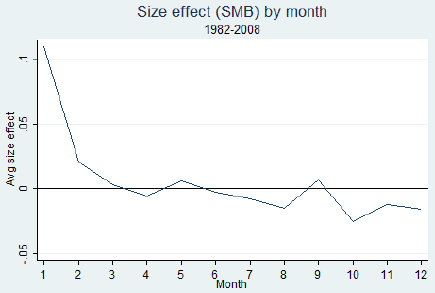Is the size effect broad and dependable, or narrow and erratic (even gone)? In the November 2010 version of his paper entitled “A Literature Review of the Size Effect”, Michael Crain summarizes past research on the size effect in equity returns, with size measured conventionally as market capitalization. Surveying the major papers on this anomaly, he finds that:
- Since introduction of small-capitalization stock funds in the U.S. and UK during the 1980s, the size effect has diminished or disappeared (see the table below). Many advisors have anchored on the pre-1980s findings.
- Factors like market liquidity help explain variation in the size effect, with an increase (decrease) in liquidity suppressing (amplifying) the effect.
- The size effect concentrates in January, with little or no presence in the other 11 months (see the chart below).
- The size effect is nonlinear, substantially concentrated in the stocks with the very smallest capitalizations (which are likely the least liquid stocks).
The following table, taken from the paper, summarizes average monthly percentage returns of NYSE, AMEX and NASDAQ firms in the largest and smallest size deciles during 1963 through 1997 and two subperiods. Results show that there is no size effect in the more recent subperiod.

The following chart, also taken from the paper, shows the average difference in returns between the decile of smallest stocks and the decile of biggest stocks (SMB) by calendar month during 1982 through 2008. Results indicate that size effect is material only in January.

In summary, evolving evidence of the size effect indicates that it is narrow and erratic rather than robust, and arguably difficult to exploit.
Note that this stream of research generally addresses gross, not net, stock returns. It is plausible that liquidity-related trading frictions are relatively high for small-capitalization stocks compared to large-capitalization stocks. Findings focused on net returns from periodically rebalanced size effect portfolios may therefore differ from those focused on frictionless gross returns.